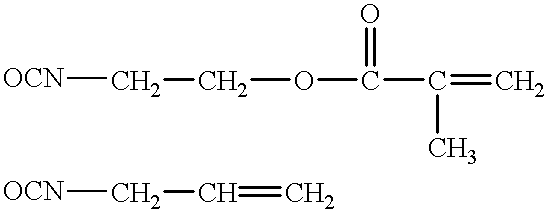Negative-acting no-process printing plates
a printing plate and negative-acting technology, applied in the field of lithographic plate production, can solve the problems of environmental pollution, reduced ink receptivity, and relatively time-consuming and expensive disposal of the above-described (i.e., wet and thermal) development process
- Summary
- Abstract
- Description
- Claims
- Application Information
AI Technical Summary
Problems solved by technology
Method used
Image
Examples
example 1
This example describes the preparation of a copolymer of acrylic acid and itaconic acid wherein the molar ratio of acrylic acid to itaconic acid is 3:1.
A glass reactor equipped with an addition funnel, a reflux condenser and a dry nitrogen air inlet tube was charged with 150 mL dry THF (water content<0.005%) and 13.0 g of itaconic acid (0.10 mol). The reaction vessel was kept under an atmosphere of nitrogen throughout the procedure. The mixture was stirred and the acid dissolved after several minutes. A solution of acrylic acid (21.6 g, 0.30 mol) in 35 mL of THF was then added to the reactor. A solution of AIBN in dry THF was then added to the stirring reaction mixture such that 2% by weight based on the total weight of the monomers of AIBN was added. The reaction was maintained at room temperature for 30 min and then refluxed for 18 hr resulting in a homogeneous, slightly hazy solution. When a drop of the reaction mixture was added into several mL of ethyl acetate, precipitation of...
example 2
This example describes the reaction of a copolymer of acrylic acid and itaconic acid (3:1 molar ratio) with IEM wherein the motor ratio of IEM to acid groups in the copolymer 0.8:1.
The resultant solution of Example 1 was maintained at a bath temperature of about 40-50.degree. C. under an atmosphere of dry air. A solution containing 0.4 g BHT, 0.4 g triphenylantimony, and 3.4 g dibutyltin dilaurate in 20 mL of dry THF was slowly added to the stirring copolymer solution. IEM (55.6 g, 0.4 mol) was then added dropwise to the mixture over a period of approximately 1 hr. After the IEM addition was complete, the reaction solution was stirred for approximately 18 hr at a bath temperature of approximately 40-50.degree. C. until the evolution of carbon dioxide ceased and the solution became homogeneous. Infrared spectral analysis showed the absence of the NCO band at about 2300 cm.sup.-1. A white polymer was precipitated by the slow addition of the reaction mixture which had been previously d...
examples 4-6
These examples describe the reaction of polyacrylic acid (mw=2,000, calculated 1.39 ephr acid functionality) with IEM wherein the molar ratio of IEM to acid groups ranges from 0.5:1 to 0.8:1.
A glass reactor was equipped with an addition funnel, a reflux condenser, a dry air inlet tube and 75 mL of dry THF (water content<0.005%). Polyacrylic acid (mw=2,000, 8.64 g, 0.12 mol acid groups) was added to the flask. After stirring at a bath temperature of 50-70.degree. C. for 2-3 hr, a cloudy solution was obtained. The temperature of the bath was maintained at 40-50.degree. C. and a solution containing 0.093 g BHT, 0.093 g triphenylantimony, and 0.64 g dibutyltin dilaurate in 5 mL of dry THF was slowly added to the stirring polymer solution. IEM then was added dropwise to the mixture over a period of 0.5-1.5 hr. The amount of IEM added for each example is listed in Table I. After adding the IEM, the mixture was stirring continuously overnight. The completion of the reaction was monitored b...
PUM
| Property | Measurement | Unit |
|---|---|---|
| thick | aaaaa | aaaaa |
| temperature | aaaaa | aaaaa |
| temperature | aaaaa | aaaaa |
Abstract
Description
Claims
Application Information
 Login to View More
Login to View More - R&D
- Intellectual Property
- Life Sciences
- Materials
- Tech Scout
- Unparalleled Data Quality
- Higher Quality Content
- 60% Fewer Hallucinations
Browse by: Latest US Patents, China's latest patents, Technical Efficacy Thesaurus, Application Domain, Technology Topic, Popular Technical Reports.
© 2025 PatSnap. All rights reserved.Legal|Privacy policy|Modern Slavery Act Transparency Statement|Sitemap|About US| Contact US: help@patsnap.com



